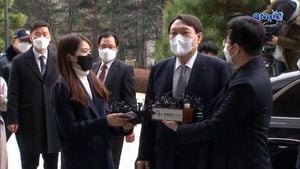As air pollution and environmental concerns mount across South Asia, authorities in two major regions—Lahore in Pakistan and Mohali in India—have stepped up enforcement efforts to combat smog and illegal mining. Their actions, which unfolded in the first days of November 2025, underscore the urgent need for coordinated responses to environmental degradation in the region.
On November 2, 2025, Lahore’s traffic police launched a sweeping crackdown aimed at curbing the city’s notorious smog problem. According to Dr. Athar Waheed, Chief Traffic Officer (CTO) of Lahore, special teams were deployed at the city’s entry and exit points to intercept vehicles that fail to meet safety and emission standards. "Vehicles without fitness certificates have now been banned from entering the city," Dr. Waheed said, as reported by local news sources.
This move comes in the wake of a dramatic escalation in enforcement. During October 2025 alone, police took action against 24,591 vehicles lacking fitness certificates—a staggering figure that reflects the scale of the challenge. In addition, more than 17,000 smoke-emitting vehicles and nearly 8,000 unsafe trolleys carrying sand or soil were fined. These numbers, according to the CTO, represent a fourfold increase compared to October of the previous year.
"Compared to October last year, four times more actions were taken this October," Dr. Waheed emphasized, highlighting the authorities’ determination to address the smog crisis. The CTO’s office further explained that the traffic police intend to intensify their operations in the coming days, signaling that the crackdown is far from over.
For many residents of Lahore, the smog season has become an annual ordeal, with air quality frequently plunging to hazardous levels. The city’s mixture of industrial emissions, vehicle exhaust, and dust from construction and transport has made it a pollution hotspot. The latest measures, authorities hope, will begin to turn the tide.
The CTO’s spokesperson encouraged citizens to do their part: "Citizens should ensure timely maintenance of their vehicles to help prevent the spread of smog." The message is clear—while enforcement is necessary, public cooperation is essential if Lahore is to breathe easier in the months ahead.
Just across the border, law enforcement in Mohali, India, has been engaged in its own environmental battle. On the same day that Lahore’s crackdown made headlines, Mohali police announced a significant escalation in their fight against illegal mining—a practice that not only depletes natural resources but also contributes to dust and particulate pollution.
According to The Tribune, special police teams from Dera Bassi, Lalru, and Handesra police stations, working under the supervision of DSP Bikramjit Singh Brar, carried out extensive checking and raids across multiple locations in Mohali. The results were immediate: four vehicles—including two tippers and two tractor-trollies, one of which was unregistered—were seized, and two individuals were arrested for their involvement in unlawful mining operations.
The crackdown led to the registration of three First Information Reports (FIRs) in the Dera Bassi sub-division, all under Sections 4(1) and 21(1) of the Mining Act. The police made it clear that their efforts are part of a broader campaign to rein in illegal mining, which has long been a source of environmental degradation and public concern in the region.
Officials described the operation as a coordinated effort, with teams executing raids and checks at various sites known for illicit extraction of sand and soil. The arrested suspects now face legal proceedings, and the confiscated vehicles are expected to be held as evidence as the cases move through the courts.
"The operation was conducted under the supervision of DSP Bikramjit Singh Brar, with special teams from the Dera Bassi, Lalru, and Handesra police stations working in tandem," police officials stated, according to The Tribune. This collaborative approach, they noted, was key to the success of the raids and the swift apprehension of suspects.
The environmental stakes are high in both Lahore and Mohali. In Lahore, unchecked vehicular emissions and poor maintenance have contributed to a toxic smog that affects millions. In Mohali, illegal mining not only erodes the landscape but also creates clouds of dust that worsen air quality and threaten local ecosystems.
While the immediate focus in Lahore is on vehicular emissions, the broader context is a city grappling with rapid urbanization and industrial growth. According to environmental experts, the combination of outdated vehicles, lax enforcement, and a booming construction sector has created a perfect storm for air pollution. The recent crackdown signals a shift toward stricter enforcement, but many wonder whether it will be enough to make a lasting impact.
On the Indian side, illegal mining has been a persistent challenge, especially in areas where demand for construction materials is high. The practice often flourishes in the shadows, with operators using unregistered vehicles and working at odd hours to evade detection. Police say that the latest raids are just the beginning, and that more operations are planned in the weeks ahead.
Environmental advocates in both regions have welcomed the crackdowns, but they caution that enforcement alone cannot solve the problem. "It’s encouraging to see action being taken, but we need comprehensive policies and sustained public engagement," said one environmentalist familiar with the situation in Punjab and Lahore. "Otherwise, these issues will just keep coming back year after year."
For now, the authorities’ message is one of zero tolerance. In Lahore, the traffic police have warned that operations will be intensified, and that vehicles without proper certification will be turned away at the city’s gates. In Mohali, police have vowed to continue their raids, targeting those who profit from illegal mining at the expense of the environment.
As the region enters the peak of the smog season, residents are watching closely to see whether these enforcement drives will bring about real change—or whether, as in years past, the haze will simply thicken once again. The coming weeks will be a crucial test for both cities, as officials balance the urgent need for clean air and sustainable development with the realities on the ground.
With authorities on both sides of the border stepping up their efforts, there’s a glimmer of hope that coordinated action and public cooperation might finally begin to clear the air—literally and figuratively—for millions who call this region home.




